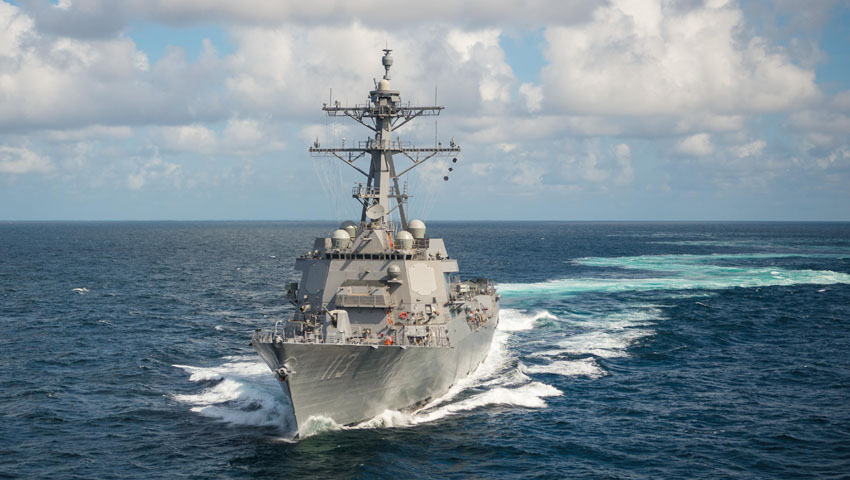Lockheed Martin, the US Missile Defense Agency (MDA) and US Navy destroyer USS John Finn successfully conducted a remote engagement (lethal intercept) of an intercontinental ballistic missile (ICBM) target. The Flight Test Maritime 44 test marks the first demonstration of an Aegis Baseline engagement of an ICBM-representative target.
To continue reading the rest of this article, please log in.
Create free account to get unlimited news articles and more!
At approximately 7:50pm Hawaii Standard Time on 16 November, the ICBM-representative target was launched from the Ronald Reagan Ballistic Missile Defense Test Site, located on Kwajalein Atoll in the Republic of the Marshall Islands, toward the broad ocean area northeast of Hawaii.
In this developmental test, the destroyer used engage-on-remote capabilities through the Command and Control Battle Management Communications (C2BMC) network as part of a defence of Hawaii scenario. After receiving tracking data from the C2BMC system, the destroyer launched a SM-3 Block IIA guided missile, which destroyed the target.
The US Missile Defence Agency (MDA), and US Navy sailors aboard the USS John Finn (DDG-113), an Aegis Ballistic Missile Defence (BMD) System-equipped destroyer, intercepted and destroyed a threat-representative ICBM target with a Standard Missile-3 (SM-3) Block IIA missile during a flight test demonstration in the broad ocean area north-east of Hawaii on 16 November.
MDA director Vice Admiral Jon Hill explained, "This was an incredible accomplishment and critical milestone for the Aegis BMD SM-3 Block IIA program. The Department is investigating the possibility of augmenting the Ground-based Midcourse Defence system by fielding additional sensors and weapon systems to hedge against unexpected developments in the missile threat.
"We have demonstrated that an Aegis BMD-equipped vessel equipped with the SM-3 Block IIA missile can defeat an ICBM-class target, which is a step in the process of determining its feasibility as part of an architecture for layered defence of the homeland. My congratulations to the entire test team, including our military and industry partners, who helped us to achieve this milestone."
Based on preliminary data, the test met its primary objective: demonstrate the ability for a SM-3 Block IIA missile to intercept an ICBM target. Program officials will continue to evaluate system performance based upon telemetry and other data obtained during the test.
Jim Sheridan, vice president and general manager at Lockheed Martin, expanded on the comments of VADM Hill, saying, "This successful intercept is a tremendous accomplishment and confirms we have inherent capability against long range ballistic missile threats that can be deployed to all our Aegis Baseline 9 ships and Aegis Ashore sites – at any moment. The success of this mission has significant underpinning to the Aegis system’s strategic ability to provide Layered Homeland Defence."
This event, designated Flight Test Aegis Weapon System-44 (FTM-44), was the sixth flight test of an Aegis BMD-equipped vessel using the SM-3 Block IIA guided missile. FTM-44, originally scheduled for May 2020, was delayed due to restrictions in personnel and equipment movement intended to reduce the spread of COVID-19.
FTM-44 satisfies a congressional mandate to evaluate the feasibility of the SM-3 Block IIA missile’s capability to defeat an ICBM threat before the end of 2020. The SM-3 Block IIA was originally designed and built for the intermediate-range ballistic missile threat set.
With the successful completion of four Aegis Baseline 9.C2.0 European Phased Adaptive Approach (EPAA) Phase 3 intercepts of intermediate-range ballistic missile (IRBM), this test demonstrated the ability to provide a globally deployed defensive weapon system.
Sheridan added, "We have evolved Aegis to perform a mission for which it wasn’t originally designed. The flexibility and adaptability of the total system – as well as our industry and government engineering teams – allows Aegis to answer the call when needed."
This missile defence system will defend the US, its friends and allies from hostile ballistic missiles from all regions, all ranges, and during all phases of flight by a single integrated system that is capable of comprehensive layered defence. As C2BMC capability continues to advance, it will help to unlock even more Aegis weapon system capability and lethality.
Working as the Aegis Combat System Engineering Agent (CSEA), Lockheed Martin engineers updated the Aegis weapon system to integrate the SM-3 IIA weapon and adapted the system to target, identify, and intercept the ICBM threat.
The Aegis Ballistic Missile Weapons System is the naval component of the US Missile Defence System. The MDA and the US Navy co-operatively manage the Aegis BMD system. Aegis BMD ships (and Aegis Ashore) receive track data via the C2BMC system, build the fire control solutions, then launch and guide the SM-3 family of missiles to destroy incoming threats.
MDA’s mission is to develop and deploy a layered Missile Defence System to defend the US, its deployed forces, allies, and friends from missile attacks of all ranges in all phases of flight.
Aegis Baseline 9.C2.0 is built from the Common Source Library (CSL) and can rapidly integrate new capabilities, including solutions for both SPY-1 and the growing SPY-7 family of radars.

 Login
Login







